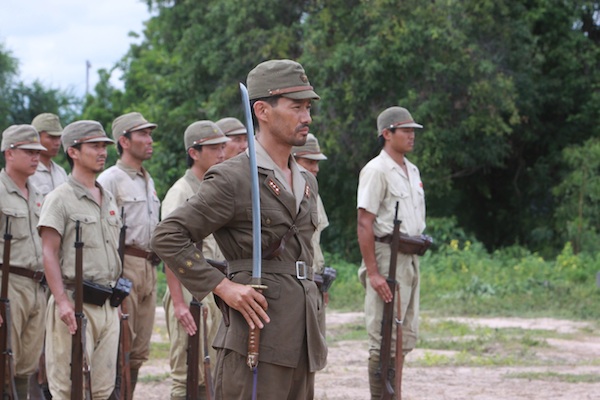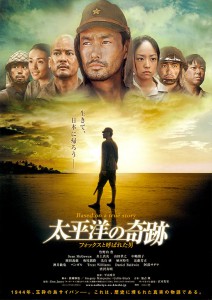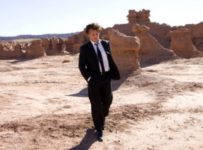Director: Hideyuki Hirayama, Cellin Gluck
Runtime: 128 minutes
Starring: Yutaka Takenouchi, Sean McGowan, Daniel Baldwin, Takayuki Yamada, Sadao Abe, Mao Inoue
Country: Japan
Rating: Highly Recommended (?)
The story of Captain Sakae Ōba has become something of a legend over the last half-century. Following the Second World War defeat of Japanese forces by the Allied Forces during the Battle of Saipan in 1944, Ōba’s led his surviving troops into the jungle where they survived for over a year and a half, eventually surrendering in December 1945 – over three months after the war ended! Don Jones, a former US Marine who was part of the US forces that were ambushed by Ōba’s men, became fascinated with his story and tracked down the Japanese captain. The two became friends, and the novel they eventually published in 1982 was a success, and was later republished in English as Oba, The Last Samurai: Saipan 1944–1945.
Following massive losses on both sides, the Battle of Saipan is declared a victory by US Colonel Pollard (Daniel Baldwin), who cares little about understanding the philosophy of the Japanese. In reality, the Japanese forces have not been defeated, but rather Captain Ōba (Yutaka Takenouchi, A Honeymoon in Hell: Mr. and Mrs. Oki’s Fabulous Trip) is steadfastly defending the island with their last ounces of strength. Captain Herman Lewis (Sean McGowan, TV’s Enterprise) has lived in Japan, and begins to grow a respect for Ōba, who the Allies dub ‘The Fox’ for his elusive strategies.
Hideyuki Hirayama’s (Sword of Desperation) ambitious film attempts to tell a grand story from both sides of the political fence, neatly depicting the action of both forces in a single film, a feat not attempted since 1970’s Tora Tora Tora. Indeed, with the exception of Clint Eastwood’s twin films Flags of Our Fathers and Letters from Iwo Jima, this kind of sprawling narrative has rarely been attempted at all. Ōba, The Last Samurai (太平洋の奇跡-フォックスと呼ばれた男-) was shot using two distinct working units, with the English-language material shot by Cellin Gluck, reportedly operating in isolation of each other. This is a risky move for any filmmaker, but in the steady hands of Hirayama, there is an attempt to give a balanced portrayal of the war. The US soldiers are depicted as casually racist, and by the same token, when a Coca-Cola bottle is found in the jungle, one Japanese soldier exclaims “Those damn, Yanks. They’re everywhere!”. Yet through the characters of Lewis and Ōba, a mutual respect can be found.
Ōba, The Last Samurai is also a visually stunning film, from an impressive opening visual effects shot to the more close-quarters claustrophobic action of the jungle skirmishes. The film was actually shot entirely on location in Thailand, and every frame maximises the lush locations. Yet it is the relationships at the heart of the tale that make this story so fascinating, and Japanese heartthrob Takenouchi does an excellent job in portraying the stoic Ōba, solidifying his reputation as a leading man after years of television dramas.
The US forces aren’t played by the typical “generic gaijin” either, with McGowan and even the scenery-chewing Baldwin carving out their own niche in a film that largely plays to the Japanese national identity. Treat Williams, who appears as a US Colonel later in the film, brings a certain gravitas to the US side of the film as well. Familiar Japanese faces, including Sadao Abe (Maiko Haaaan!!!, Yatterman), Takayuki Yamada (13 Assassins, GANTZ) and Toshiaki Karasawa (20th Century Boys) ensure that Japan’s story is in capable hands, although Mao Inoue’s (Boys Over Flowers) sole female character is somewhat underdeveloped.
With McGowan’s flat narration, it is almost the US perspective that wins out, although this is undeniably a Japanese film for a local audience. Perhaps this is the point: while history may be told by the victors, heroes are born on both sides of the trenches, and their names live on forever.

Ōba, The Last Samurai is screening on 19 November (Sydney) and 1 December (Melbourne) 2011 at the 15th Japanese Film Festival in Australia.







—-Meanwhile, franchise slum Hollywood has
BALKED the –20th –30th –40th –50th and NOW
60th Anniversaries of the awesomely relevant
——————–KOREAN WAR————————